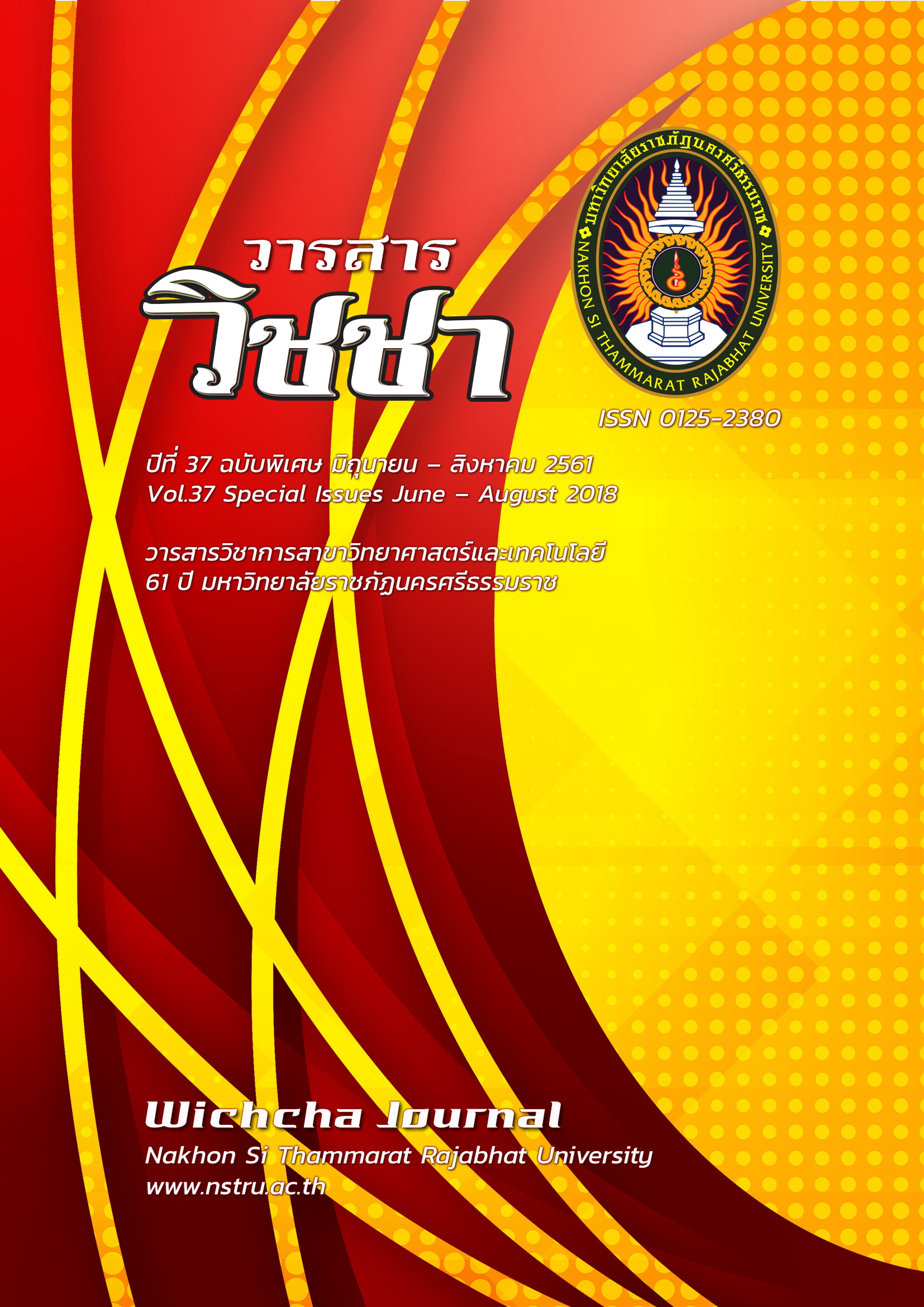การพัฒนาชุดฝึกอบรมระบบควบคุมทางกลสำหรับการสอนนักศึกษา เทคโนโลยีอุตสาหกรรม
Main Article Content
Abstract
The objectives of this research were to construct and find out of the training package on automatic mechanical control systems; to examine the learning achievements with the training package on automatic mechanical control systems; and to examine the learning satisfactions through the training package on automatic mechanical control systems. The research methodology was research and development. The 30 participants were senior undergraduate mechanical technology students of Faculty of Industrial Technology at Nakhon Si Thammarat Rajabhat University that studies in the semester of 2/2014. Participants were collected by systematic sampling with the preliminary test. The research instrumentation was the training package on automatic mechanical control systems, pre-test and post-test and operation sheets. Data were analyzed by mean, standard deviation and t-test dependent. The research results revealed that the efficiency of the training package on automatic mechanical control systems showed that the mass-damper-spring was 88.53/81.11. The undergraduate industrial technology students have done the mass-damper-spring been statistical significantly difference greater than 0.05. The learning satisfaction through the training package on automatic mechanical control systems was at 4.79, and was at the highest level.
Article Details
เนื้อหาและข้อมูลในบทความที่ลงตีพิมพ์ในวารสารวิชชา มหาวิทยาลัยราชภัฏนครศรีธรรมราช ถือเป็นข้อคิดเห็นและความรับผิดชอบของผู้เขียนบทความโดยตรง ซึ่งกองบรรณาธิการวารสารไม่จำเป็นต้องเห็นด้วยหรือร่วมรับผิดชอบใด ๆ
บทความ ข้อมูล เนื้อหา รูปภาพ ฯลฯ ที่ได้รับการตีพิมพ์ในวารสารวิชชา มหาวิทยาลัยราชภัฏนครศรีธรรมราช ถือเป็นลิขสิทธ์ของวารสารวิชชา มหาวิทยาลัยราชภัฏนครศรีธรรมราช หากบุคคลหรือหน่วยงานใดต้องการนำข้อมูลทั้งหมดหรือส่วนหนึ่งส่วนใดไปเผยแพร่ต่อหรือเพื่อการกระทำการใด ๆ จะต้องได้รับอนุญาตเป็นลายลักษณ์อักษรจากวารสารวิชชา มหาวิทยาลัยราชภัฏนครศรีธรรมราชก่อนเท่านั้น
The content and information in the article published in Wichcha journal Nakhon Si Thammarat Rajabhat University, It is the opinion and responsibility of the author of the article. The editorial journals do not need to agree. Or share any responsibility.
References
วิทวัส ดวงภุมเมศ และวารีรัตน์ แก้วอุไร. (2560). การจัดการเรียนรู้ในยุคไทยแลนด์ 4.0 ด้วยการเรียนรู้อย่างกระตือรือร้น. วารสารมนุษย์ศาสตร์และสังคมศาสตร์ บัณฑิตวิทยาลัยมหาวิทยาลัยราชภัฏพิบูลสงคราม, 11(2), 1-13.
วีระยุทธ สุดสมบูรณ์ และบุญส่ง เหมวัฒน์. (2555). The Development of Automotive Mechatronic Systems Training Strategy for Enhancing Problem Solving Skills within Current Situation. วารสารมหาวิทยาลัยศรีนครินทรวิโรฒ (สาขาวิทยาศาสตร์และเทคโนโลยี), 4(8), 51-69.
สุรัตน์ ธัญญะภูมิ และกฤษณะ ศรีมาวรรณ์. (2552). การสร้างชุดสาธิตการควบคุมระดับน้ำด้วยวิธีการควบคุมแบบพีไอดีและฟัซซี โดยใช้โปรแกรม LabVIEW. ปริญญานิพนธ์ครุศาสตร์อุตสาหกรรมบัณฑิต. มหาวิทยาลัยเทคโนโลยีพระจอมเกล้าพระนครเหนือ, กรุงเทพฯ.
Fraenkel, J.R. (1993). How to Design and Evaluate Research in Education. Singapore: McGraw-Hill Inc.
Nise, N.S. (2000). Control Systems Engineering. (3rd ed). New York: John Wiley & Sons.
Ogata, K. (2004). System dynamics. Upper Saddle River. NJ: Pearson Prentice Hall.
Rowell, D. and Wormley, D. N. (1998). System Dynamics: An Introduction. New Jersey: Prentice Hall.
Sudsomboon, W. (2011). Effects of a Computer-Based Concept-Mapping: The Learning Innovation in Industrial Education. Technical Education Journal of King Mongkut’s University of Technology North Bangkok, 2(2), 11-19.
Sudsomboon, W. (2013). Applying Case-Based Reasoning to Teach Analysis of Non-Holonomic Mechanical Systems. In the 3rd International Conference on Sciences and Social Sciences (ICSSS 2013). July 18-19. Rajabhat Maha Sarakham University, Maha Sarakham, Thailand. 17-25.
Sudsomboon, W. and Maungmungkun, T. (2013). Integrating Case-Based Reasoning
Approach in an Undergraduate Industrial Technology Research Course. In the 6th International Conference on Educational Reform (ICER 2013). February 23-24. Sokha Angkor Resort. Siem Reap. Cambodia. 220-226.


